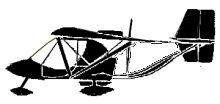
ASN Wikibase Occurrence # 288968
This information is added by users of ASN. Neither ASN nor the Flight Safety Foundation are responsible for the completeness or correctness of this information.
If you feel this information is incomplete or incorrect, you can submit corrected information.
| Date: | Saturday 13 August 2011 |
| Time: | 06:20 LT |
| Type: |  Porbeck John M SLIPSTREAM GENESIS |
| Owner/operator: | Joseph Maxim |
| Registration: | N53QB |
| MSN: | JMP-01 |
| Total airframe hrs: | 60 hours |
| Engine model: | COMPACT RA MZ202 |
| Fatalities: | Fatalities: 0 / Occupants: 1 |
| Aircraft damage: | Substantial |
| Category: | Accident |
| Location: | Bryan, Texas -
 United States of America United States of America
|
| Phase: | Approach |
| Nature: | Private |
| Departure airport: | Bryan-Coulter Field, TX (CFD/KCFD) |
| Bryan-Coulter Field, TX (CFD/KCFD) | |
| Investigating agency: | NTSB |
| Confidence Rating: |
After a detailed preflight inspection and runup of the experimental airplane, the pilot intended to do solo pattern work before giving the airplane's owner a bi-annual flight review. The owner watched the airplane takeoff and start to climb, then turn toward a left crosswind to enter the pattern downwind. The owner stated that the airplane would have been encountering a quartering tailwind of about 6-7 knots during the turn to downwind. He then saw the left wing losing lift and the right wing tipping upward at the same time, and the airplane quickly losing altitude. The airplane was operating with full engine power. The airplane then impacted the ground and skidded about 49 yards along a grassy area before coming to rest. After the accident, the pilot stated that just after the airplane cleared the ground during takeoff, he began a climb and turned toward a downwind position. The airplane then suddenly began to stall. After adding power, the airplane started to recover, but the altitude was too low to complete the recovery. Examination of the airplane wreckage did not reveal any mechanical malfunctions or failures with the engine, airframe, or flight controls that would have precluded normal operation. The pilot had a total time of 2,300 flight hours; however, he only had about 1.5 total hours in the accident airplane. He had flown the airplane 2 days before the accident flight for about 1 hour, and the accident flight was his second flight in the airplane. It is likely that the pilot was not sufficiently familiar with the flight characteristics of the light experimental airplane.
Probable Cause: The pilot's failure to maintain adequate airspeed and attitude during a turn toward downwind, which resulted in an aerodynamic stall. Contributing to the accident was the pilot's limited experience in the experimental airplane.
Accident investigation:
 |
|
Sources:
NTSB CEN11LA672
Location
Revision history:
| Date/time | Contributor | Updates |
|---|---|---|
| 05-Oct-2022 08:19 | ASN Update Bot | Added |
Corrections or additions? ... Edit this accident description
The Aviation Safety Network is an exclusive service provided by:


 ©2024 Flight Safety Foundation
©2024 Flight Safety Foundation